
|
|
Font Size:
|
||||
|
|
|
|
||||
STATISTICAL BRIEF #246:
Characteristics of Uninsured Young Adults: Estimates for the U.S. Civilian Noninstitutionalized Population, 19-23 Years of Age, 2006
Highlights
- Young adults ages 19-23 were almost twice as likely to be uninsured all year as adults ages 45-64 (24.1 percent versus 13.3 percent).
- Hispanic young adults were most likely to be uninsured all year (43.9 percent).
- Full year uninsured young adults were only about half as likely as ever insured adults to have a usual source of care (36.4 percent versus 69.8 percent).
- More than two-thirds (67.4 percent) of full year uninsured young adults had no ambulatory doctor visits in 2006.
- In 2006, 3.5 million employed young adults were uninsured all year.
Introduction
Health insurance coverage for the U.S. population is an important issue. Health insurance is critical in ensuring individuals get timely access to essential health care. Since the uninsured population is not homogeneous, it is important to independently examine the characteristics of each vulnerable population group in order to better inform health initiatives for each group at risk. This Statistical Brief focuses on young adults ages 19-23 in the U.S. civilian noninstitutionalized population.Young adults are often not covered by their parents' health insurance plan unless they are full-time students. Furthermore, those who are working at first time jobs often do not qualify for public insurance programs based on income. In addition, some of these young adults are not offered health insurance or decline to purchase health insurance because of the cost.
This Statistical Brief analyzes 2006 data from the Household Component of the Medical Expenditure Panel Survey (MEPS-HC) to examine estimates for young adults that were either uninsured for all or part of 2006. It identifies groups most at risk of being uninsured. All differences between estimates discussed in the text are statistically significant at the 0.05 level unless otherwise noted.
Findings
In 2006, 46.5 percent (9.4 million) of the 19-23 year old population were uninsured for at least one month in 2006 and 24.1 percent (4.9 million) were uninsured for the entire year (data not shown). The wide variation in the health insurance coverage rate by differing time intervals indicates that young adults are at particular risk of alternating between some coverage and no coverage at all. Furthermore, young adults 19-23 years of age are disproportionately represented among the ever uninsured 19-64 population. While individuals in this age group accounted for only about 11 percent (11.1 percent) of the 19-64 population, they accounted for almost 18 percent (17.6 percent) of the ever uninsured population (figure 1).With respect to age, young adults ages 19-23 were more likely to be without health insurance all year compared to older adults in 2006. Young adults were 1.2 times as likely to be uninsured all year as adults 24-44, and 1.8 times as likely to be uninsured all year as adults ages 45-64 (24.1 percent versus 19.9 percent and 13.3 percent; respectively) (figure 2).
Differences in uninsured rates in the young adult population varied according to race/ethnicity, sex, poverty, and educational attainment (figure 3).
Hispanic young adults were more than twice as likely as blacks or whites/others to lack health insurance for the entire year (43.9 percent versus 21.1 percent and 19.0 percent). Young adult men were more likely than young adult women to lack insurance for the entire year. Overall, 29.8 percent of male young adults were uninsured all year compared to only 17.9 percent of their female counterparts.
In regard to poverty status, 31 percent of poor young adults were uninsured all year as compared to 22.7 percent of nonpoor young adults. Lower levels of education were also found to be associated with being uninsured all year in the young adult population. Young adults who did not graduate from high school were twice as likely to be uninsured as those with at least some college education (30.6 percent versus 15.5 percent).
Insurance companies often allow young adults to be covered on their parents health insurance policy until they are 23 years old if they are full-time students. In fact, the data demonstrate that only 18.6 percent of full year uninsured young adults were full-time students in contrast to 42.2 percent of those ever having health insurance in 2006 (figure 4).
The majority of uninsured young adults are employed either full-time (45.8 percent) or part-time (25.9 percent). [(Figure 5) This translates to 1.3 million part-time employed and 2.2 million full-time employed young adults who lacked health insurance for all of 2006.]
Lack of health insurance often leads to significant barriers to health care access. One indicator of access to care is having a usual source of health care. Full year uninsured young adults were almost twice as likely as ever insured young adults to lack a usual source of care (63.6 percent versus 30.2 percent). Young adults uninsured all year were more than twice as likely to have been unable to obtain necessary health care as their insured counterparts (6.4 percent versus 3.0 percent). Not having health insurance also contributes to differences in utilization of health care services. Only about 33 percent of young adults uninsured all year had one or more ambulatory doctor visits in 2006, compared to nearly 65 percent of insured young adults (figure 6).
Most full year uninsured young adults are relatively healthy. More than 94 percent of full year uninsured young adults had perceived health rankings of excellent/very good/ or good, and only 6.5 percent had ever been told by a health care provider that they had a chronic condition.
In addition, in response to a question designed to evoke opinions on the value of health, about 30 percent of full year uninsured young adults felt health insurance was not worth the cost. In contrast, only 18.5 percent of those having health insurance for at least part of the year reported health insurance was not worth the cost (data not shown).
Data Source
The estimates shown in this Statistical Brief are drawn from analyses conducted by the MEPS staff from the following public use file: 2006 Full Year Consolidated Data File, HC-105.Definitions
Health insurance status- Any private insurance: This group includes those who, at any time in the survey year, had individual or group plan coverage for medical or related expenses or who were covered by TRICARE (which covers retired members of the uniformed services and the spouses and children of active-duty military). Private health insurance plans may include prepaid health plans such as health maintenance organizations but they exclude extra cash coverage plans, medical benefits linked only to specific diseases (dread disease plans), and casualty benefit plans (such as automobile insurance).
- Uninsured: This group includes all persons who did not have private or public insurance coverage at any time in the calendar year.
Age
Age was defined as the age of the person in the last survey round in 2006.
Race/ethnicity
Classification by race and ethnicity was based on information reported for each family member. Respondents were asked if each family member's race was best described as American Indian, Alaska Native, Asian or Pacific Islander, black, white, or other. They also were asked if each family member's main national origin or ancestry was Puerto Rican; Cuban; Mexican, Mexicano, Mexican American, or Chicano; other Latin American; or other Spanish. All persons whose main national origin or ancestry was reported in one of these Hispanic groups, regardless of racial background, were classified as Hispanic. Since the Hispanic grouping can include black Hispanic, white Hispanic, Asian and Pacific Islanders Hispanic, and other Hispanic, the race categories of black, white, Asian and Pacific Islanders, and other only include non-Hispanics for the race/ethnicity classifications. MEPS respondents who reported other single or multiple races and were non-Hispanic were included in the other category. For this analysis, the following classification by race and ethnicity was used: Hispanic (of any race), non-Hispanic blacks single race, non-Hispanic whites single race, and others, and non-Hispanic Asian and Pacific Islanders single race.
Poverty status
Sample persons were classified according to the total yearly income of their family. Within a household, all people related by blood, marriage, or adoption were considered to be a family. Poverty status categories are defined by the ratio of family income to the Federal income thresholds, which control for family size and age of the head of family. Poverty status was based on annual income in 2006. Poverty status categories are defined as follows:
- Poor: Persons in families with income less than or equal to the poverty line, including those who had negative income.
- Nonpoor: Persons in families with income over the poverty line.
Measured as the highest level of education each individual has attained, as of the date they first entered MEPS. We use the following three education categories:
- Less than high school--having less than 12 years of education.
- High school graduate--having 12 years of education.
- At least some college--having more than 12 years of education.
Usual source of care
For each individual family member, MEPS ascertains whether there is a particular doctors office, clinic, health center, or other place that the individual usually goes to if he/she is sick or needs advice about his/her health.
Employment status
- Full-time--a person who worked 35 or more hours per week.
- Part-time--a person who worked less than 35 hours per week.
For purposes of this Statistical Brief, an ambulatory doctor visit is defined as any visit to an office-based medical provider or an outpatient department visit in 2006.
Health status
In every round, the respondent was asked the following question to rate the health of every member of the family: "In general, compared to other people of (PERSON)'s age, would you say that (PERSON)'s health is excellent, very good, good, fair, or poor?" For this brief, the response categories excellent, very good, and good were collapsed. Health status was defined as of the last round in 2006 the person was in the survey.
Value of Health Insurance
All adults in the MEPS survey were asked to fill out a self-administered questionnaire. As part of the questionnaire, a series of attitudinal questions were asked to elicit opinions on a number of health related issues. One of the statements presented was "Health insurance is not worth the money it costs." For this analysis those who agreed somewhat or agreed strongly were coded as feeling health insurance was not worth the cost.
About MEPS-HC
MEPS-HC is a nationally representative longitudinal survey that collects detailed information on health care utilization and expenditures, health insurance, and health status, as well as a wide variety of social, demographic, and economic characteristics for the U.S. civilian noninstitutionalized population. It is cosponsored by the Agency for Healthcare Research and Quality and the National Center for Health Statistics.For more information about MEPS, call the MEPS information coordinator at AHRQ (301) 427-1656 or visit the MEPS Web site at http://www.meps.ahrq.gov.
References
For a detailed description of the MEPS-HC survey design, sample design, and methods used to minimize sources of nonsampling error, see the following publications:Cohen, J. Design and Methods of the Medical Expenditure Panel Survey Household Component. MEPS Methodology Report No. 1. AHCPR Pub. No. 97-0026. Rockville, MD: Agency for Health Care Policy and Research, 1997. http://www.meps.ahrq.gov/mepsweb/data_files/publications/mr1/mr1.shtml
Cohen, S. Sample Design of the 1996 Medical Expenditure Panel Survey Household Component. MEPS Methodology Report No. 2. AHCPR Pub. No. 97-0027. Rockville, MD: Agency for Health Care Policy and Research, 1997. http://www.meps.ahrq.gov/mepsweb/data_files/publications/mr2/mr2.shtml
Cohen, S. Design Strategies and Innovations in the Medical Expenditure Panel Survey. Medical Care, July 2003: 41(7) Supplement: III-5-III-12.
Ezzati-Rice, T.M., Rohde, F., and Greenblatt, J. Sample Design of the Medical Expenditure Panel Survey Household Component, 1998-2007. Methodology Report No. 22. March 2008. Agency for Healthcare Research and Quality, Rockville, MD. http://www.meps.ahrq.gov/mepsweb/data_files/publications/mr22/mr22.shtml
Suggested Citation
Beauregard, K. and Carper, K. Characteristics of Uninsured Young Adults: Estimates for the U.S. Civilian Noninstitutionalized Population 19-23 Years of Age, 2006. Statistical Brief # 246. June 2009. Agency for Healthcare Research and Quality, Rockville, MD. http://www.meps.ahrq.gov/mepsweb/data_files/publications/st246/stat246.shtmlAHRQ welcomes questions and comments from readers of this publication who are interested in obtaining more information about access, cost, use, financing, and quality of health care in the United States. We also invite you to tell us how you are using this Statistical Brief and other MEPS data and tools and to share suggestions on how MEPS products might be enhanced to further meet your needs. Please e-mail us at mepsprojectdirector@ahrq.hhs.gov or send a letter to the address below:
Steven B. Cohen, PhD, Director
Center for Financing, Access, and Cost Trends
Agency for Healthcare Research and Quality
540 Gaither Road
Rockville, MD 20850
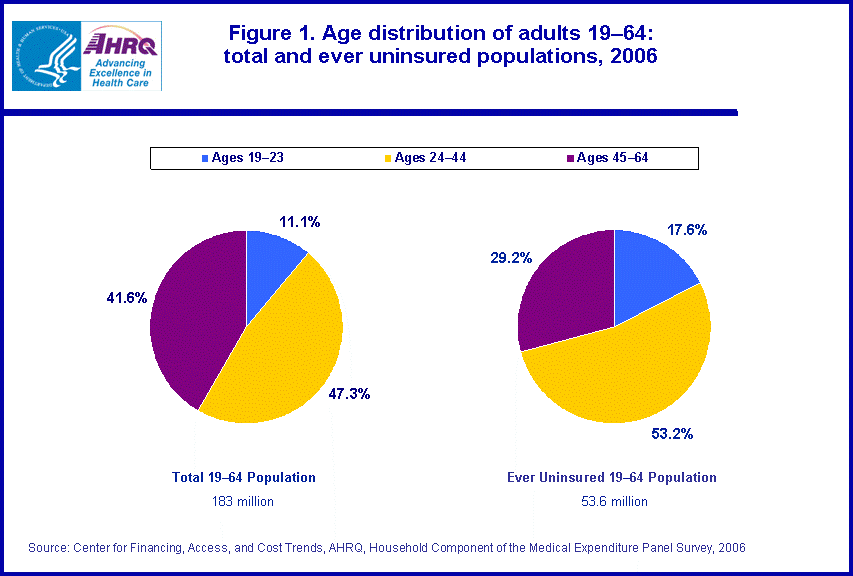 |
||||||||||||||||||||||||||||
Source: Center for Financing, Access, and Cost Trends, AHRQ, Household Component of the Medical Expenditure Panel Survey, 2006 | ||||||||||||||||||||||||||||
|
|
||||||||||||||||||||||||||||
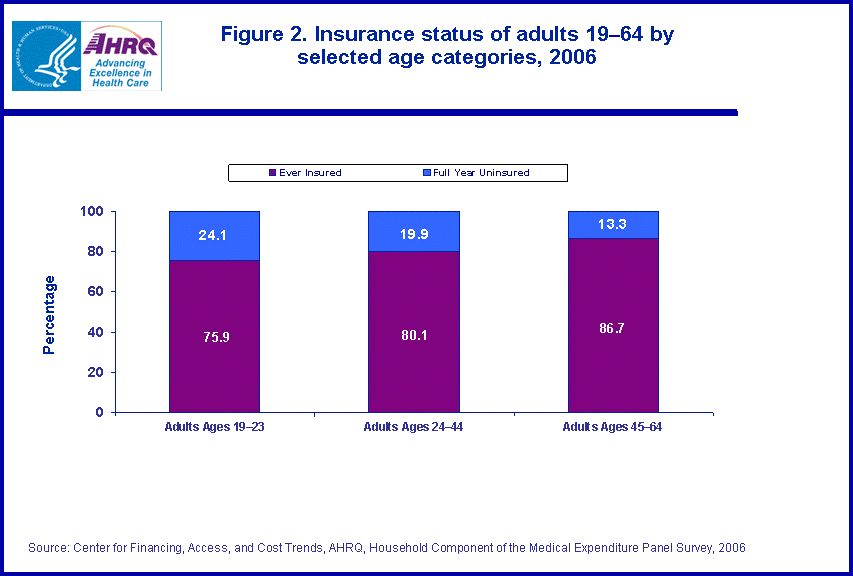 |
||||||||||||||||||||||||||||
Source: Center for Financing, Access, and Cost Trends, AHRQ, Household Component of the Medical Expenditure Panel Survey, 2006 | ||||||||||||||||||||||||||||
|
|
||||||||||||||||||||||||||||
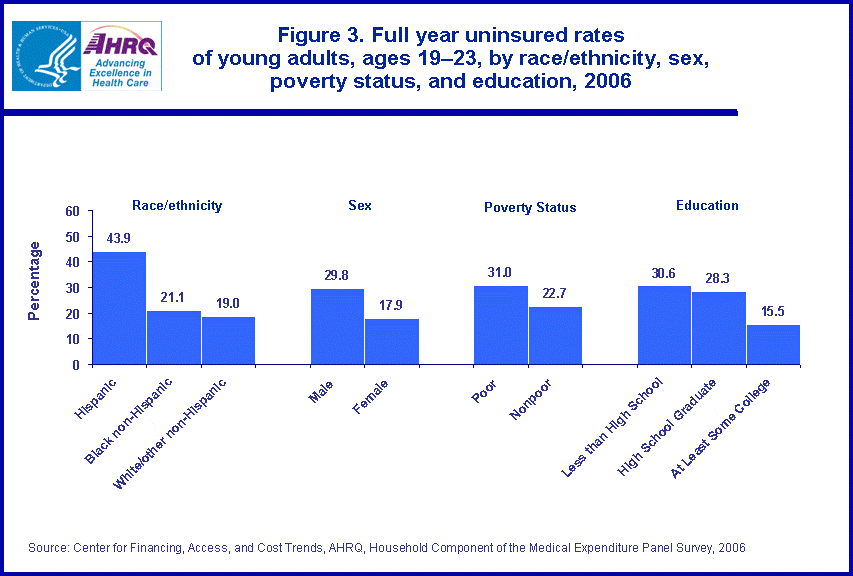 |
||||||||||||||||||||||||||||
Source: Center for Financing, Access, and Cost Trends, AHRQ, Household Component of the Medical Expenditure Panel Survey, 2006
Source: Center for Financing, Access, and Cost Trends, AHRQ, Household Component of the Medical Expenditure Panel Survey, 2006
Source: Center for Financing, Access, and Cost Trends, AHRQ, Household Component of the Medical Expenditure Panel Survey, 2006
Source: Center for Financing, Access, and Cost Trends, AHRQ, Household Component of the Medical Expenditure Panel Survey, 2006 | ||||||||||||||||||||||||||||
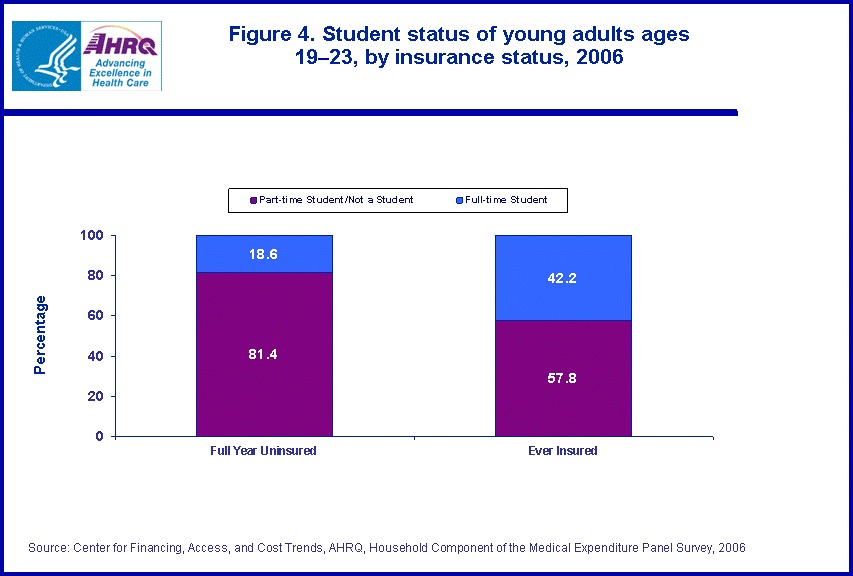 |
||||||||||||||||||||||||||||
Source: Center for Financing, Access, and Cost Trends, AHRQ, Household Component of the Medical Expenditure Panel Survey, 2006 | ||||||||||||||||||||||||||||
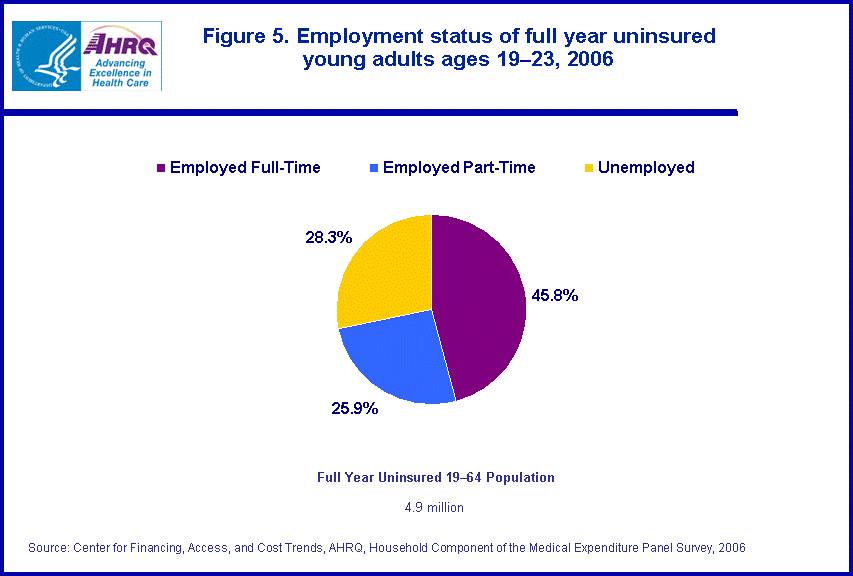 |
||||||||||||||||||||||||||||
Source: Center for Financing, Access, and Cost Trends, AHRQ, Household Component of the Medical Expenditure Panel Survey, 2006 | ||||||||||||||||||||||||||||
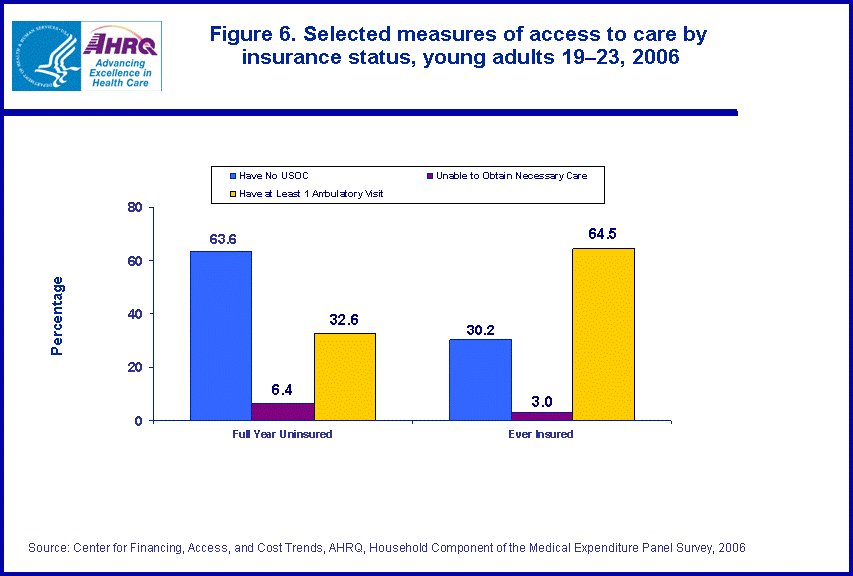 |
||||||||||||||||||||||||||||
Source: Center for Financing, Access, and Cost Trends, AHRQ, Household Component of the Medical Expenditure Panel Survey, 2006 | ||||||||||||||||||||||||||||
|
|


